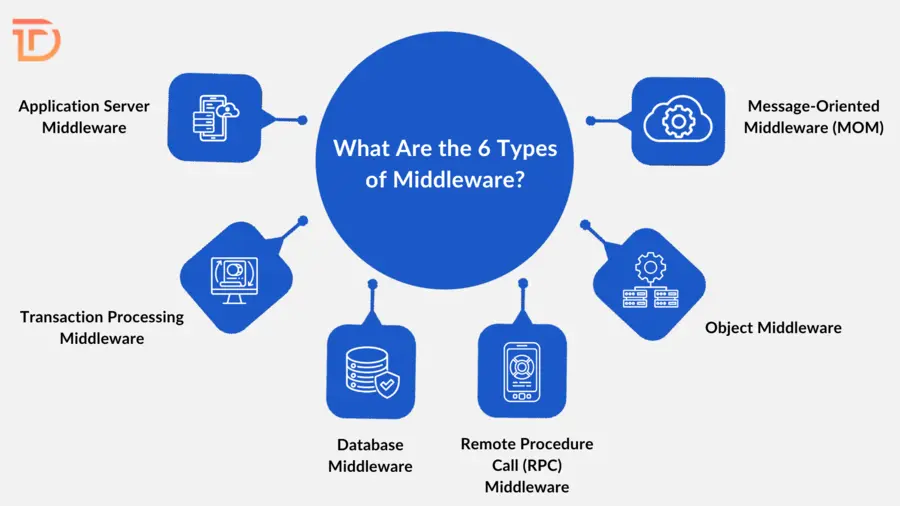Technology powers the modern world through countless interconnected systems. From web platforms to enterprise-grade applications, every successful digital product relies on a carefully structured foundation. Among the many layers supporting that foundation, two crucial terms stand out: middleware and backend. Both often appear together during technical discussions, leading to confusion about their specific roles. Mistaking one for the other may result in flawed architecture decisions. Each serves a unique purpose, and understanding the differences can help businesses build scalable, secure, and reliable systems. Every digital product depends on proper data flow, secure transactions, and smooth user experiences. These results come from well-structured communication between different software layers, where middleware and backend play distinct yet complementary roles. In this blog, we will delve into what middleware is, its types, the core differences between middleware and backend, and whether middleware and APIs serve the same purpose.
Understanding Middleware
Middleware refers to the software layer that sits between the user interface and the backend logic of an application. It facilitates communication between applications, services, and systems that may not interact directly. Often considered the glue holding software components together, middleware helps manage data exchange, authorization, and service orchestration.
Applications that depend on multiple services need a stable system to coordinate those services. Middleware handles these tasks behind the scenes. When a user logs into a platform, their request passes through middleware, which checks credentials, logs the activity, and then forwards the request to the backend for processing.
Developers rely on middleware to simplify cross-platform communication and reduce the burden on the backend. Tasks like monitoring user activity, converting data formats, or enforcing consistent rules across different services all fall under middleware’s responsibilities. Without it, developers would need to replicate the same functionality in multiple places, increasing complexity and reducing maintainability.
What Are the 6 Types of Middleware?
Middleware isn’t a single tool or framework. Instead, it comes in different forms, each designed to solve specific challenges across software environments. Knowing the six major types of middleware helps developers and stakeholders identify the best fit for a particular application.

Message-Oriented Middleware (MOM)
MOM ensures efficient communication between distributed components through message queues. Applications that handle high transaction volumes or asynchronous operations benefit from MOM. It guarantees that messages arrive at their destination even when services operate at different speeds.
Object Middleware
Object middleware supports the interaction between objects located on different systems or written in different programming languages. It offers standardized interfaces, allowing developers to call remote objects as if they were local ones. Enterprise systems often depend on this middleware to enable reuse and scalability.
Remote Procedure Call (RPC) Middleware
RPC middleware allows functions on remote machines to be called like local methods. It hides the complexity of network communication from developers, enabling smoother implementation of distributed applications. RPC makes it easier to execute remote tasks and manage their responses.
Database Middleware
Connecting applications to databases involves more than just establishing a connection. Database middleware handles connection pooling, query optimization, and transaction management. It ensures that data access remains consistent and efficient, especially in applications with multiple concurrent users.
Transaction Processing Middleware
Systems requiring guaranteed transaction integrity, such as financial platforms, use transaction processing middleware. It coordinates operations across different databases or services while preserving data consistency. If one part of the transaction fails, the middleware ensures that all changes are rolled back.
Application Server Middleware
Often found in enterprise environments, this type supports web applications by managing tasks such as load balancing, session tracking, and caching. Application server middleware provides the tools needed for scalable systems capable of handling large user bases and fluctuating demand.
What is a Backend?
The backend is the server-side part of a software application responsible for managing data, implementing business logic, connecting to databases, and handling system operations. It acts behind the scenes to process requests from users and ensure smooth interactions between the application’s components.
Serving as the operational backbone, the backend receives and interprets inputs from the frontend, executes the required processes, and sends back relevant outputs. This layer is responsible for everything from validating user actions to managing data flow.
From submitting a form to updating account settings, every user activity involves a chain of backend processes. These include database lookups, logic execution, and data storage, all designed to ensure consistent and responsive application behavior.
Developers working on the backend focus on building APIs, managing databases, and configuring servers. They ensure code security, performance optimization, and infrastructure scalability. These are factors that keep modern applications running reliably under varying loads.
While middleware connects different components of a tech stack, the backend performs the actual execution of core operations. Every critical decision, algorithm, and data transaction is handled here. A strong backend ensures stability, while a poorly designed one risks causing delays, system crashes, or vulnerabilities.
Difference Between Backend and Middleware
| Aspect | Middleware | Backend |
|---|---|---|
| Primary Role | Acts as a communication layer between software components | Executes business logic and manages data |
| Purpose | Routes requests, handles authentication, and manages service-to-service communication | Processes requests, performs database interactions, and generates responses |
| Scope | Operates across multiple services to ensure consistency in request handling, logging, and errors | Tied specifically to the application’s logic and its direct data storage interactions |
| Functionality | Simplifies integrations and service orchestration | Defines application behavior according to business rules |
| System Design Benefits | Enhances flexibility and adaptability across services | Focuses on efficiency and implements core application logic |
| Separation Advantages | Promotes modularity and consistency across a distributed architecture | Helps maintain clear logic and simplify long-term backend maintenance |
Is Middleware the Same as the API?
Middleware and APIs work closely but represent different layers of the system. An API defines the rules and structure for software components to communicate. It lists available functions, accepted inputs, and expected responses. Middleware manages the process of calling those APIs, transforming inputs, and ensuring delivery.
An API is like a contract between the client and the server. Middleware ensures that all the conditions in that contract are met during communication. While the API tells developers what can be done, middleware determines how it gets done efficiently and securely.
Middleware also enhances the way APIs are used. It can log each API call, enforce rate limits, and transform responses into a consistent format. These functions go beyond the API’s scope, ensuring smooth operation in complex environments.
Without middleware, developers might struggle to integrate multiple APIs consistently. Middleware handles those behind-the-scenes interactions, freeing up the application logic to focus on delivering value to users.
Understanding the separation between APIs and middleware helps create better designs. Middleware improves operational control and adds reliability, while APIs define what actions are possible across services.
Why Use Middleware?
Middleware adds significant value to software development by enabling smooth interactions between components that might not otherwise communicate effectively. The following are the key reasons to use middleware.
Enables Seamless Communication Between Disconnected Components
Middleware acts as a bridge and allows various software modules, often built on different architectures or platforms, to interact without friction. It ensures smooth data flow and coordination between otherwise incompatible systems.
Promotes Consistent Logic and Policy Implementation
Instead of repeating code in multiple services, middleware allows developers to define rules and functions in one place and apply them uniformly. It helps maintain consistency, reduce redundancy, and simplify future updates across the entire application.
Centralizes Security Controls for Streamlined Access Management
Authentication and authorization rules are handled at the middleware layer. Developers gain a single point to manage security policies, ensuring that all incoming requests are validated consistently and vulnerabilities are minimized.
Improves Interoperability Across Diverse Technologies
Organizations often use software from multiple vendors or build tools using different programming languages. Middleware brings these technologies together and allows them to function cohesively without requiring major redevelopment of existing systems.
Enhances Performance and Reliability Through Smart Traffic Handling
With features such as message queuing, load balancing, and caching, middleware helps systems manage high traffic volumes more efficiently. It detects failures and can reroute or retry requests to improve uptime and system reliability.
Simplifies Integration With Third-Party APIs and Services
Middleware manages tasks such as formatting data, checking permissions, and controlling API usage when dealing with external services. It reduces manual coding, improves development speed, and lowers the risk of errors.
Final Words
Software systems operate through collaboration between multiple layers. Middleware and backend perform different jobs within that collaboration. Middleware manages communication, request handling, and service coordination. The backend performs logic processing, manages databases, and executes commands that fulfill user actions. A clear understanding of their roles improves system design, reduces complexity, and leads to better scalability. Developers gain flexibility through middleware and strength through a stable backend architecture. Together, they form the foundation of high-performing applications.
Dreamer Technoland builds a custom software with deep expertise in backend development and middleware integration. Businesses seeking performance, security, and scalability benefit from a team that understands how to structure applications from the ground up. Whether it’s a mobile app, web platform, or MVP, we offer tailored solutions built for long-term success. With a proven record of delivering seamless experiences for a decade, we turn complex requirements into functional, future-ready software.







